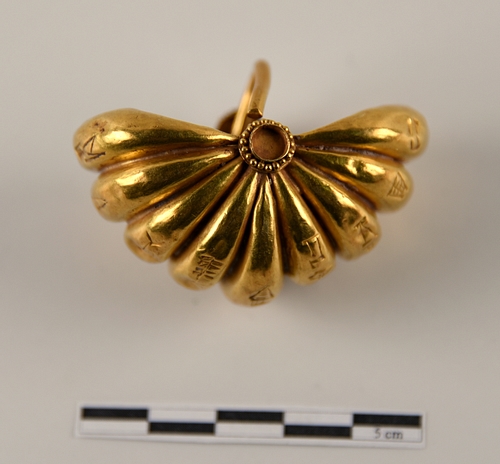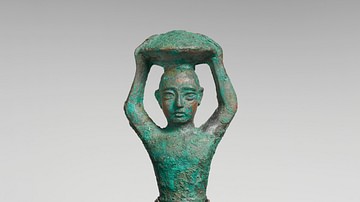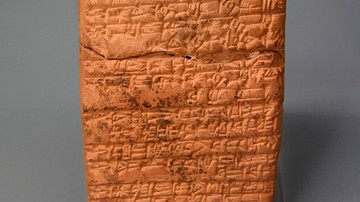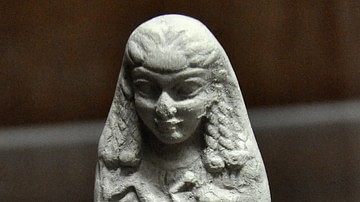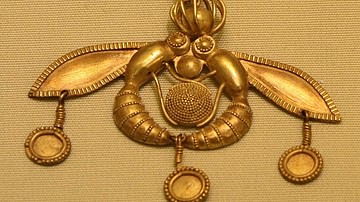Gold is a treasure, and he who possesses it does all he wishes to in this world, and succeeds in helping souls into paradise.
On June 22, 2005, the Sulaymaniyah Museum of Iraqi Kurdistan purchased a pair of gold earrings and on the same day these jewellery items received a registration number of “SM 2892“. They cost the bargain price of 7,000.00 USD. Both earrings weigh approximately 48 grams and are of a 24-carat purity.
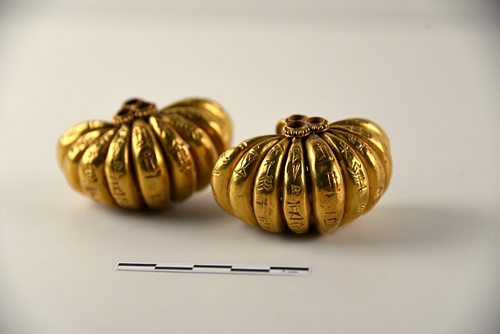
Each earring has what appears to be a shape of a half-globular fruit, with flattened upper and lower surfaces, such as a pumpkin or a tangerine, and is composed of nine lunar-shaped segments. The individual segments have no pulp and therefore the inner part of the earring is hollow. The maximum dimensions are 5 cm (length), 2.5 cm (height), and 2.5 cm (radius). The outer surface of each earring was carved with Akkadian cuneiform signs. The text was arranged vertically on the surface of each lunar-shaped segment and is copied on the corresponding side of the fellow earring, so that they complement each other, like the sides of a medal.
The upper surface of the earring was decorated at its “centre” with a group of three circles (each 0.5 cm in diameter) joined together tangentially forming a trifoliate shape. This triple combination is surrounded by an outer rim. In between them, the goldsmith filled in the space with tiny gold spheres. The centre of the lower surface is made of a double circle (about 0.5 cm in diameter); once again, the gap between these two circles was filled out with tiny gold spheres. Some of the spheres have been lost and were not replaced with modern ones. There is a 2-mm thick arch linking the upper trifoliate group with the lower circular centre. The latter end is free and this appears to be the point where it can be inserted into the ear lobule of the wearer.
A few years after its acquisition by the Sulaymaniyah Museum, Professor Farook Al-Rawi transliterated the cuneiform text. What have we got? The earrings were a gift from Shulgi, one of the neo-Sumerian kings of the Ur III dynasty (reigned 2093-2046 BCE) to one of the chiefs of the servants of a temple; the name of that man was Khazi.
The text reads:
To the goddess Mammetum, his lady, for the life of Shulgi, king of Ur, -azi, the chief official, his servant, dedicated for him.
Mammetum (or Mamitu) was an Akkadian goddess of fate and destiny and her residence was the underworld (Irkalla or Ir-Kalla in Akkadian).
Therefore, these earrings are 4000 years old. The precise provenance and date of excavation are unknown. They seem to have been unearthed somewhere in Southern Mesopotamia (modern-day southern Iraq). They bear no registration number of any museum. It is unclear whether they were excavated before or after the US-led invasion of Iraq in 2003. When they were bought by the Sulaymaniyah Museum, the earrings were in an almost perfect state of preservation. This is something very strange for an ancient Mesopotamian pair of relatively large earrings of almost pure gold; they were not grossly deformed. In addition, the shape and the carvings of the earrings are somewhat unusual if we compare them to Mesopotamian earrings dating back to the same period. Actually, the authenticity of the earrings was questioned initially.
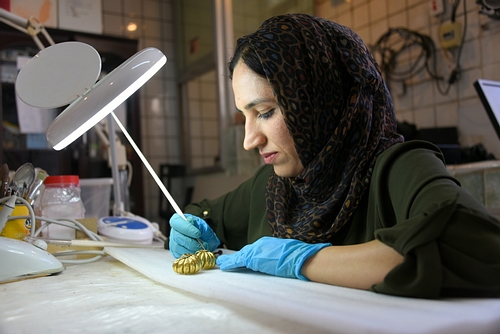
Miss Niyan Sabir is doing a routine and regular preservation work on the pair of the earrings at the lab of the Sulaymaniyah Museum. Ur III Period, reign of Shulgi, 2093-2046 BCE. Probably from Southern Mesopotamia, modern-day Iraq. October 18, 2017; exclusive photo.
The earrings are now one of the major “icons” and “representations” of the Sulaymaniyah Museum. The very first time I shot the earrings was in 2013. Since then, I have published them, as illustrations, on many social media and websites but this is the first article specifically addressing these gold pieces on the net.
All of the following pictures are exclusive and have never previously been published. I used a Nikon D750 and AF-S Nikkor 28-300mm 1:3.5-5.6 G ED VR lens. Now enjoy the images!
Earring One
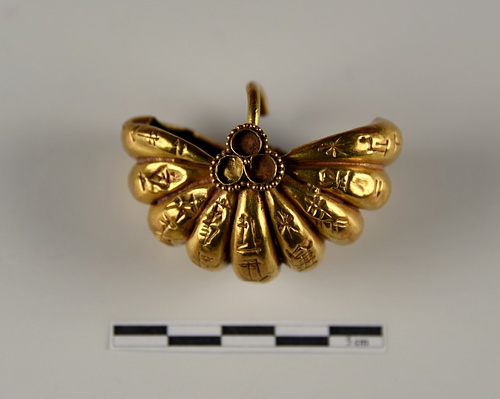
This is the upper surface of earring one. The right lower circle is broken and at the centre of the trifoliate group lies a single golden sphere; compare this with the corresponding group on ring two. The cuneiform text is read vertically, from the upper surface downwards on each segment, and it continues from right to left.
![A Gold Earring from Ur III [Reverse View]](https://www.worldhistory.org/img/r/p/500x600/7468.jpg?v=1713468543)
The lower surface of earring one. Six gold spheres were lost and were not replaced.
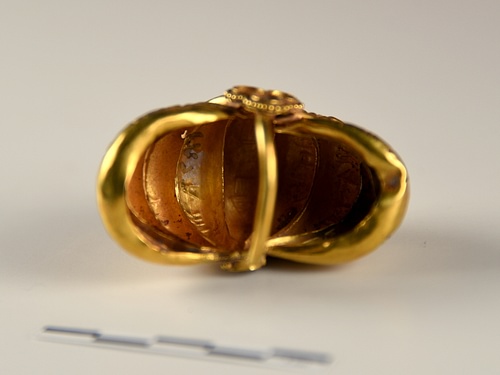
The interior hollow surface of earring one. Note how the carved cuneiform signs appear on this side and how the goldsmith joined the “lunar-shaped” segments of the earring.
Earring Two
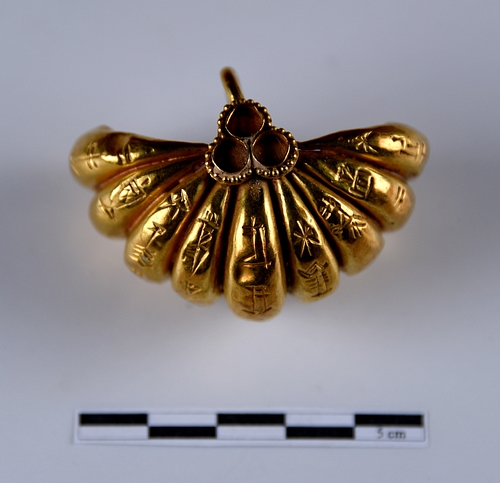
This is the upper surface of earring two. Note how the cuneiform signs were carved and distributed, and their distance from the centre.
The lower surface of earing two.
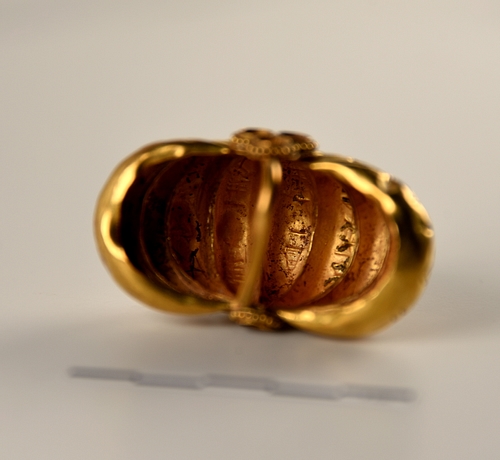
The interior hollow surface of earring two.
The Pair of Earrings
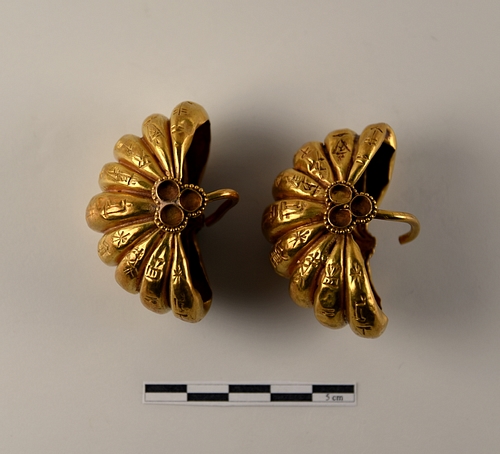
These are the upper surfaces of both earrings, with their concavity facing right. Note that the cuneiform signs are identical on the corresponding sides.
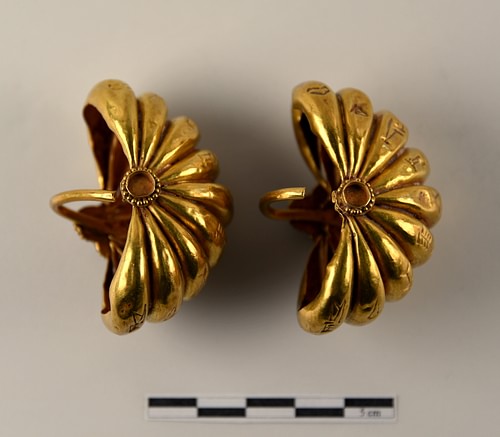
These are the lower surfaces of both earrings. The free end of the golden arch can be clearly seen.

Both earrings were placed in a mirror-image position, with the lower surfaces facing each other.
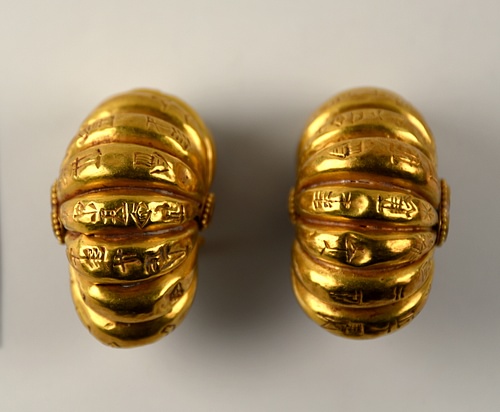
Both earrings were placed in a mirror-image position, with the lower surfaces facing each other.
It is noteworthy to mention that in the years 2014 and 2015, some groups and pages on Facebook and Twitter took some of my previous images and posted them, not only without permission but also intentionally fabricating and falsifying a caption (for some reason or another) that these earrings belonged to Pu-Abi of the Royal Cemetery of Ur and were found by Sir Leonard Woolley.
Acknowledgments
Many thanks go to Miss Niyan Sabir, an archaeologist and curator at the Sulaymaniyah Museum, for her kind cooperation and help. A special gratitude goes to Mr. Hashim Hama Abdullah, director of the Sulaymaniyah Museum for his continuous and endless assistance.

